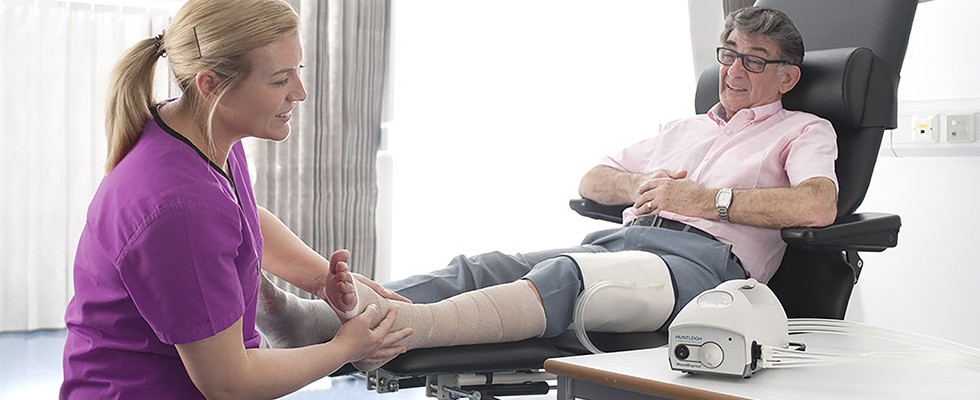
Lower extremity venous disease, also known as chronic venous insufficiency (CVI) and chronic venous disorders, encompasses a broad spectrum of functional abnormalities of the venous system, according to a 2017 definition published in Ostomy/Wound Management. The severity of CVI can range from spider veins and edema to more complicated findings like lipodermatosclerosis, hemosiderin staining, brawny edema and venous leg ulcers (VLUs).
VLUs are wounds located below the knee that are difficult to treat due to the nature of controlling edema and the result of CVI and lymphedema. A 2014 study published in the Journal of Vascular Surgery found that 80% to 90% of all leg ulcers are VLUs and that 1% of people will develop a VLU in their lifetime. A 2016 Journal of Wound, Ostomy, and Continence Nursing study found that VLUs affect 4% of adults 65 years or older, and ulcers in this Medicare population account for 90% of all leg ulcers. Ninety-seven percent of patients with VLUs experience prolonged healing and often will develop recurrent leg ulcers, according to the study.
The VLU population represents a significant economic burden to the health care system. A 2014 study found that VLU patients had increased inpatient stays, emergency department visits and home health care days. They incurred additional annual incremental medical costs as well. The total economic burden of VLUs was found to be $14.9 billion annually. VLU patients had 77% more hospitalizations, 50% more emergency room visits and 27% more physician office visits.
A New Form of Compression
The gold standard of treatment for VLUs is multi-layered compression bandaging with 30 to 40 millimeters of mercury (mmHg) at the ankle. Advanced wound dressings are placed beneath the bandaging to address the wound characteristics. Correctly applied compression is the foundation of VLU treatment and has shown improved healing rates and outcomes in patients who are compliant with properly applied multi-layer bandaging, the 2016 study found.
However, chronic disease management fatigue takes a toll in this patient population. A number of patients who need compression, or who require higher levels of compression, fail to utilize it for many reasons. Standard of care (SOC) multi-layered compression dressings unfortunately may be fraught with issues—pain, discomfort and exudate can cause poor patient compliance or the application of less than the desired 30 to 40 mmHg compression at the ankle. Patients have reduced strength and difficulty applying their hosiery or reusable Velcro type of compression. Once a patient needs compression, it becomes a lifelong challenge to manage.
A 2020 study published in Eplasty found that the use of intermittent pneumatic compression (IPC) in addition to SOC therapy has been shown to improve circulation to lower extremity wounds, thus decreasing pain and edema and improving healing rates and patient outcomes. IPC is not routinely utilized in every wound care clinic. The Wound Ostomy and Continence Society (WOCN) has been active in studying the use of IPC in patients with VLUs. In June 2022, the WOCN Society updated a consensus- and evidence-based VLU algorithm with the addition of lymphedema, since lymphedema shares many features with VLUs. The document summarizes the data for VLU management and provides a decision tree that recommends IPC be used in addition to SOC therapy to increase circulation, decrease pain and edema and improve wound healing for VLUs.
IPC can be a game changer for patients with VLUs. Improving blood flow to wounds is imperative for healing. The use of IPC can improve wound healing to lower extremity ulcers two times faster than use of just SOC alone the Eplasty study showed. Oftentimes, the full leg garment of the IPC is difficult to apply and, because it compresses over the wound, is painful for patients to use. This can be a barrier for patients to use IPC to improve blood flow and improve healing to the leg ulcer. Other alternatives must be used to provide this therapy while decreasing pain.
A recent article in the International Wound Journal describes a study with an IPC cuff that is placed on the thigh away from the wound. The study used 20 healthy volunteers and 13 patients with leg ulcers of different etiologies. Arterial and venous velocity was measured below the cuff. The results found that venous and arterial flow were increased with this application of IPC. Compression at the thigh level can produce positive hemodynamic effects in patients with chronic leg ulcers, which leads to improved healing rates in patients with VLUs.
CVI and lymphedema are difficult disease processes to manage from both the patient and clinician perspective. Pain, increased exudate and discomfort are barriers to management of venous leg ulcers with SOC therapy alone. IPC can be a non-invasive addition to the treatment plan that gets results.
Getting IPC on patients with VLUs early in the disease process improves healing rates, decreases pain and edema, decreases costs associated with VLUs, decreases the burden to health care and enhances patient quality of life.
